2006 MERCEDES-BENZ SPRINTER sensor
[x] Cancel search: sensorPage 2229 of 2305
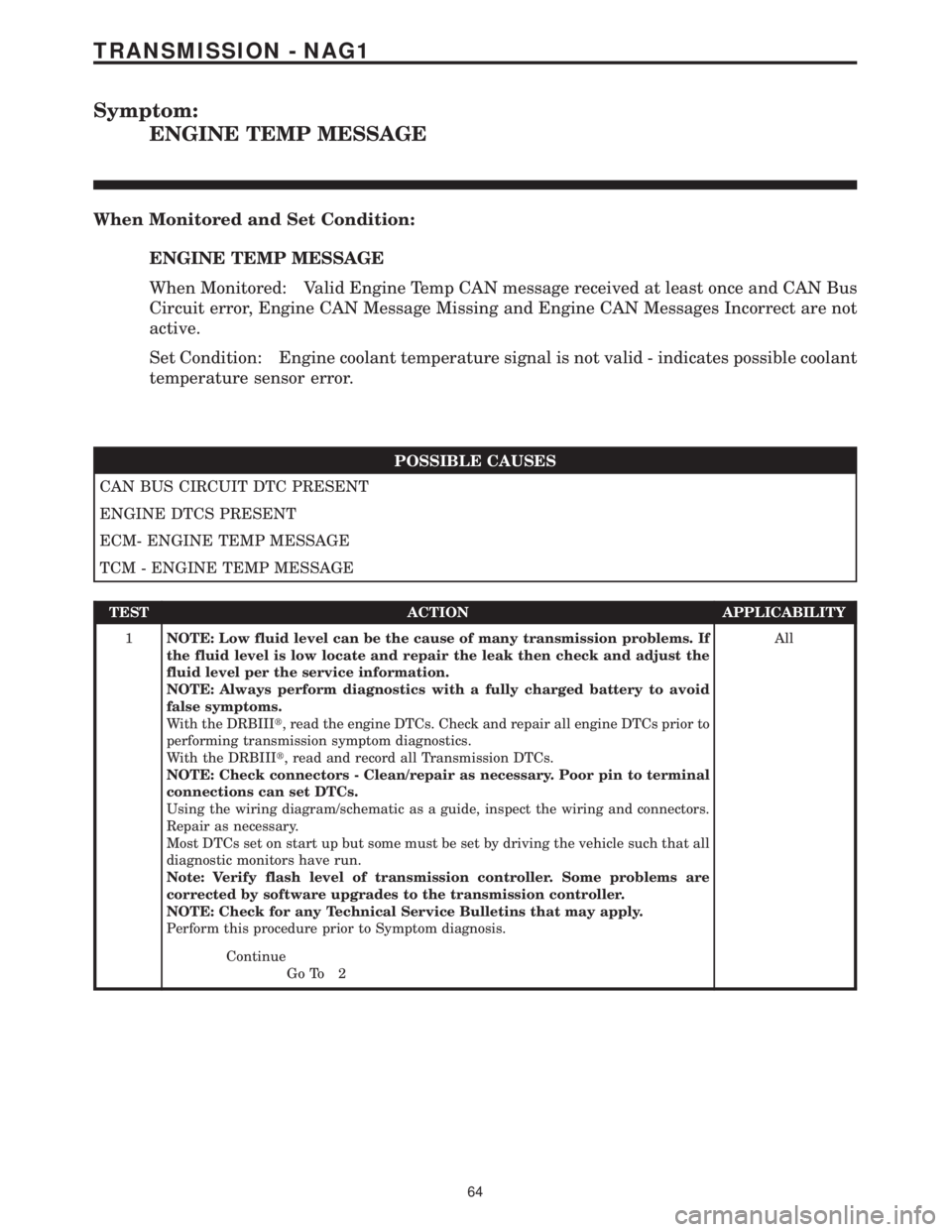
Symptom:
ENGINE TEMP MESSAGE
When Monitored and Set Condition:
ENGINE TEMP MESSAGE
When Monitored: Valid Engine Temp CAN message received at least once and CAN Bus
Circuit error, Engine CAN Message Missing and Engine CAN Messages Incorrect are not
active.
Set Condition: Engine coolant temperature signal is not valid - indicates possible coolant
temperature sensor error.
POSSIBLE CAUSES
CAN BUS CIRCUIT DTC PRESENT
ENGINE DTCS PRESENT
ECM- ENGINE TEMP MESSAGE
TCM - ENGINE TEMP MESSAGE
TEST ACTION APPLICABILITY
1NOTE: Low fluid level can be the cause of many transmission problems. If
the fluid level is low locate and repair the leak then check and adjust the
fluid level per the service information.
NOTE: Always perform diagnostics with a fully charged battery to avoid
false symptoms.
With the DRBIIIt, read the engine DTCs. Check and repair all engine DTCs prior to
performing transmission symptom diagnostics.
With the DRBIIIt, read and record all Transmission DTCs.
NOTE: Check connectors - Clean/repair as necessary. Poor pin to terminal
connections can set DTCs.
Using the wiring diagram/schematic as a guide, inspect the wiring and connectors.
Repair as necessary.
Most DTCs set on start up but some must be set by driving the vehicle such that all
diagnostic monitors have run.
Note: Verify flash level of transmission controller. Some problems are
corrected by software upgrades to the transmission controller.
NOTE: Check for any Technical Service Bulletins that may apply.
Perform this procedure prior to Symptom diagnosis.All
Continue
Go To 2
64
TRANSMISSION - NAG1
Page 2230 of 2305
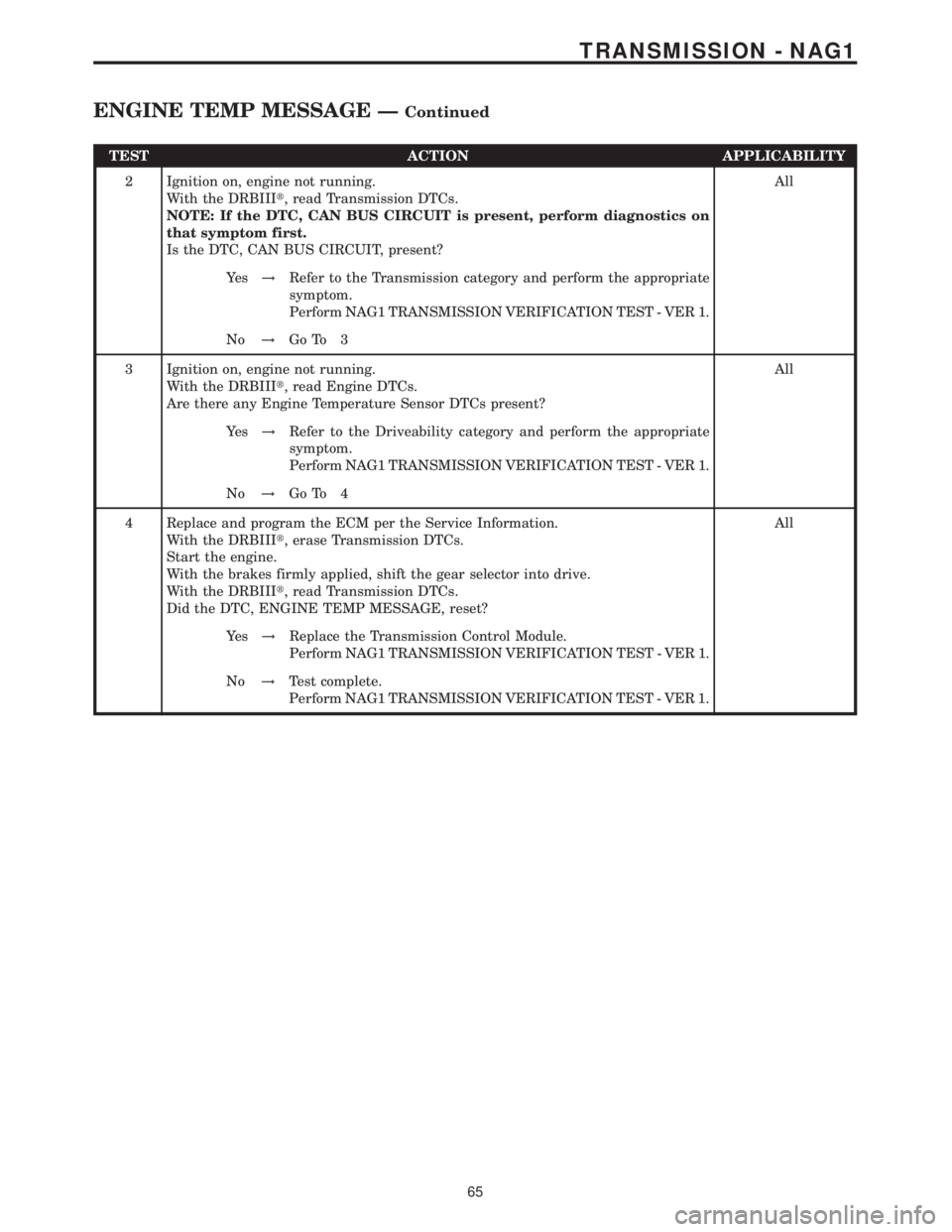
TEST ACTION APPLICABILITY
2 Ignition on, engine not running.
With the DRBIIIt, read Transmission DTCs.
NOTE: If the DTC, CAN BUS CIRCUIT is present, perform diagnostics on
that symptom first.
Is the DTC, CAN BUS CIRCUIT, present?All
Ye s!Refer to the Transmission category and perform the appropriate
symptom.
Perform NAG1 TRANSMISSION VERIFICATION TEST - VER 1.
No!Go To 3
3 Ignition on, engine not running.
With the DRBIIIt, read Engine DTCs.
Are there any Engine Temperature Sensor DTCs present?All
Ye s!Refer to the Driveability category and perform the appropriate
symptom.
Perform NAG1 TRANSMISSION VERIFICATION TEST - VER 1.
No!Go To 4
4 Replace and program the ECM per the Service Information.
With the DRBIIIt, erase Transmission DTCs.
Start the engine.
With the brakes firmly applied, shift the gear selector into drive.
With the DRBIIIt, read Transmission DTCs.
Did the DTC, ENGINE TEMP MESSAGE, reset?All
Ye s!Replace the Transmission Control Module.
Perform NAG1 TRANSMISSION VERIFICATION TEST - VER 1.
No!Test complete.
Perform NAG1 TRANSMISSION VERIFICATION TEST - VER 1.
65
TRANSMISSION - NAG1
ENGINE TEMP MESSAGE ÐContinued
Page 2239 of 2305
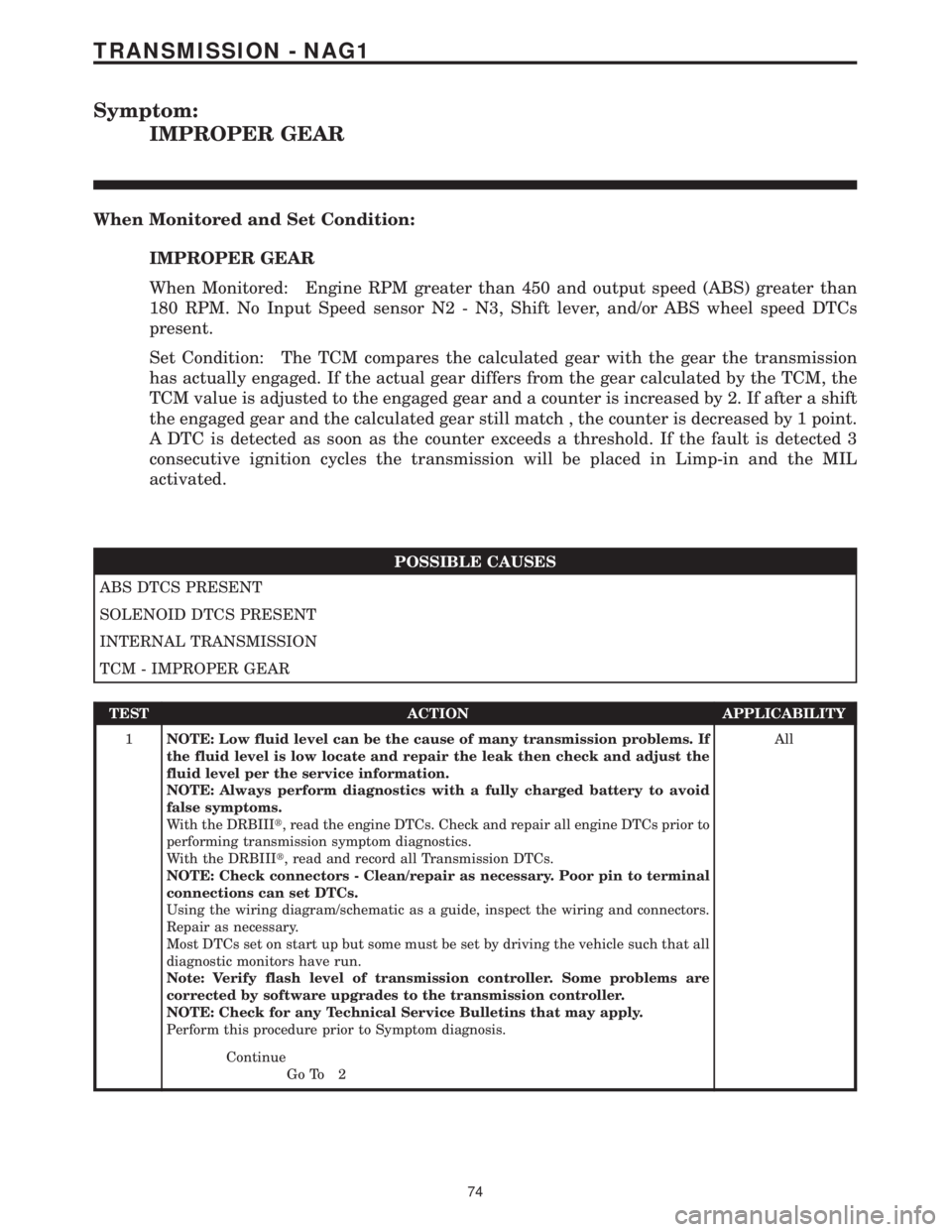
Symptom:
IMPROPER GEAR
When Monitored and Set Condition:
IMPROPER GEAR
When Monitored: Engine RPM greater than 450 and output speed (ABS) greater than
180 RPM. No Input Speed sensor N2 - N3, Shift lever, and/or ABS wheel speed DTCs
present.
Set Condition: The TCM compares the calculated gear with the gear the transmission
has actually engaged. If the actual gear differs from the gear calculated by the TCM, the
TCM value is adjusted to the engaged gear and a counter is increased by 2. If after a shift
the engaged gear and the calculated gear still match , the counter is decreased by 1 point.
A DTC is detected as soon as the counter exceeds a threshold. If the fault is detected 3
consecutive ignition cycles the transmission will be placed in Limp-in and the MIL
activated.
POSSIBLE CAUSES
ABS DTCS PRESENT
SOLENOID DTCS PRESENT
INTERNAL TRANSMISSION
TCM - IMPROPER GEAR
TEST ACTION APPLICABILITY
1NOTE: Low fluid level can be the cause of many transmission problems. If
the fluid level is low locate and repair the leak then check and adjust the
fluid level per the service information.
NOTE: Always perform diagnostics with a fully charged battery to avoid
false symptoms.
With the DRBIIIt, read the engine DTCs. Check and repair all engine DTCs prior to
performing transmission symptom diagnostics.
With the DRBIIIt, read and record all Transmission DTCs.
NOTE: Check connectors - Clean/repair as necessary. Poor pin to terminal
connections can set DTCs.
Using the wiring diagram/schematic as a guide, inspect the wiring and connectors.
Repair as necessary.
Most DTCs set on start up but some must be set by driving the vehicle such that all
diagnostic monitors have run.
Note: Verify flash level of transmission controller. Some problems are
corrected by software upgrades to the transmission controller.
NOTE: Check for any Technical Service Bulletins that may apply.
Perform this procedure prior to Symptom diagnosis.All
Continue
Go To 2
74
TRANSMISSION - NAG1
Page 2241 of 2305
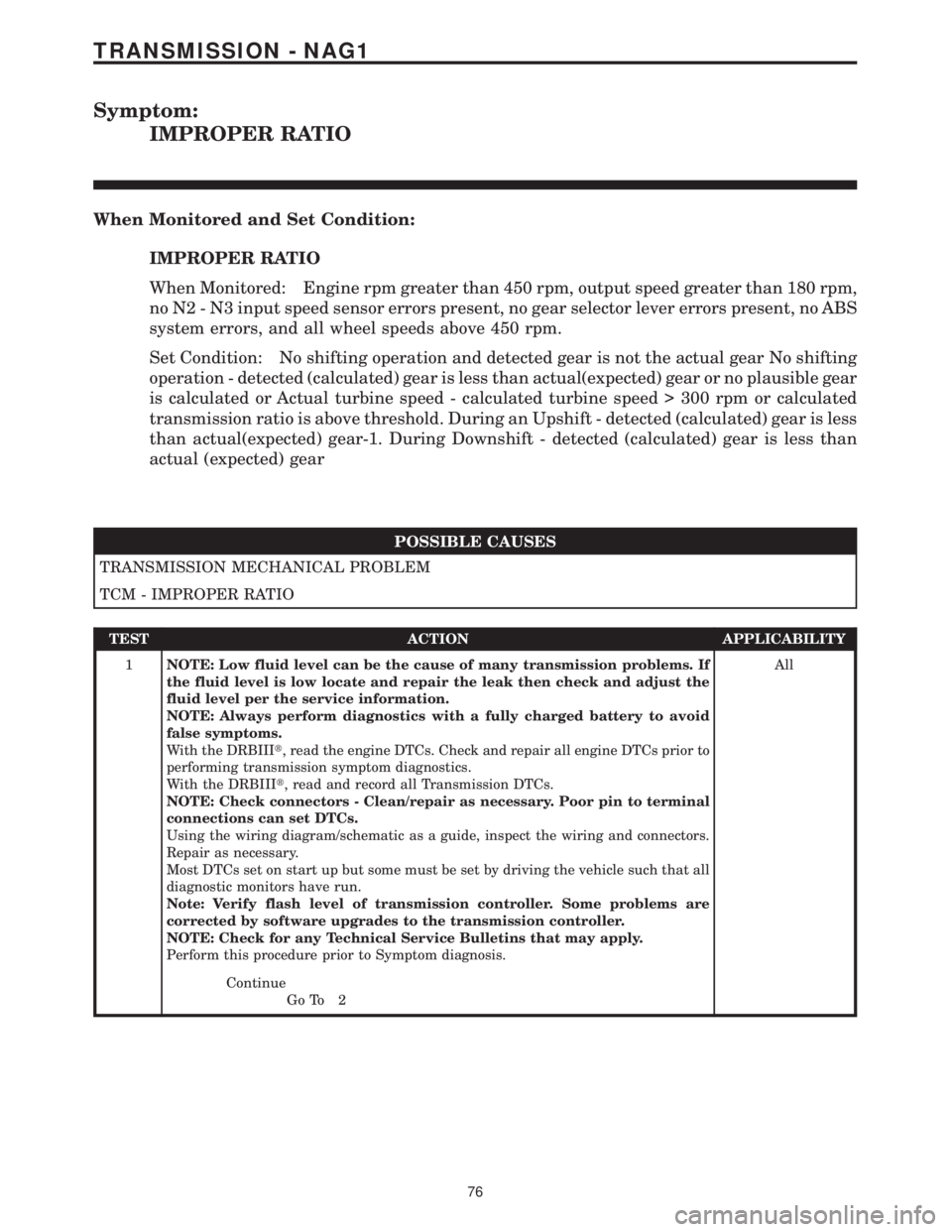
Symptom:
IMPROPER RATIO
When Monitored and Set Condition:
IMPROPER RATIO
When Monitored: Engine rpm greater than 450 rpm, output speed greater than 180 rpm,
no N2 - N3 input speed sensor errors present, no gear selector lever errors present, no ABS
system errors, and all wheel speeds above 450 rpm.
Set Condition: No shifting operation and detected gear is not the actual gear No shifting
operation - detected (calculated) gear is less than actual(expected) gear or no plausible gear
is calculated or Actual turbine speed - calculated turbine speed > 300 rpm or calculated
transmission ratio is above threshold. During an Upshift - detected (calculated) gear is less
than actual(expected) gear-1. During Downshift - detected (calculated) gear is less than
actual (expected) gear
POSSIBLE CAUSES
TRANSMISSION MECHANICAL PROBLEM
TCM - IMPROPER RATIO
TEST ACTION APPLICABILITY
1NOTE: Low fluid level can be the cause of many transmission problems. If
the fluid level is low locate and repair the leak then check and adjust the
fluid level per the service information.
NOTE: Always perform diagnostics with a fully charged battery to avoid
false symptoms.
With the DRBIIIt, read the engine DTCs. Check and repair all engine DTCs prior to
performing transmission symptom diagnostics.
With the DRBIIIt, read and record all Transmission DTCs.
NOTE: Check connectors - Clean/repair as necessary. Poor pin to terminal
connections can set DTCs.
Using the wiring diagram/schematic as a guide, inspect the wiring and connectors.
Repair as necessary.
Most DTCs set on start up but some must be set by driving the vehicle such that all
diagnostic monitors have run.
Note: Verify flash level of transmission controller. Some problems are
corrected by software upgrades to the transmission controller.
NOTE: Check for any Technical Service Bulletins that may apply.
Perform this procedure prior to Symptom diagnosis.All
Continue
Go To 2
76
TRANSMISSION - NAG1
Page 2243 of 2305
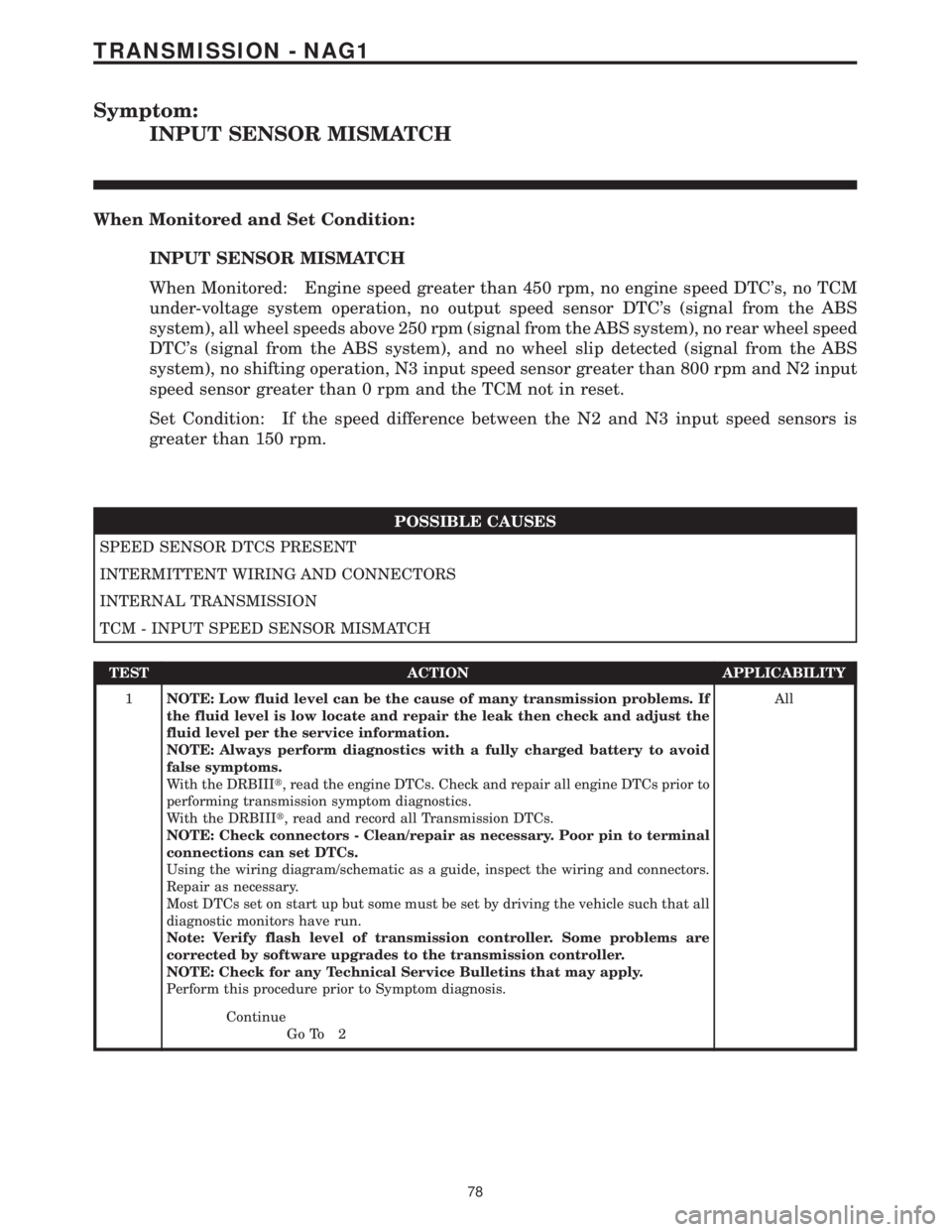
Symptom:
INPUT SENSOR MISMATCH
When Monitored and Set Condition:
INPUT SENSOR MISMATCH
When Monitored: Engine speed greater than 450 rpm, no engine speed DTC's, no TCM
under-voltage system operation, no output speed sensor DTC's (signal from the ABS
system), all wheel speeds above 250 rpm (signal from the ABS system), no rear wheel speed
DTC's (signal from the ABS system), and no wheel slip detected (signal from the ABS
system), no shifting operation, N3 input speed sensor greater than 800 rpm and N2 input
speed sensor greater than 0 rpm and the TCM not in reset.
Set Condition: If the speed difference between the N2 and N3 input speed sensors is
greater than 150 rpm.
POSSIBLE CAUSES
SPEED SENSOR DTCS PRESENT
INTERMITTENT WIRING AND CONNECTORS
INTERNAL TRANSMISSION
TCM - INPUT SPEED SENSOR MISMATCH
TEST ACTION APPLICABILITY
1NOTE: Low fluid level can be the cause of many transmission problems. If
the fluid level is low locate and repair the leak then check and adjust the
fluid level per the service information.
NOTE: Always perform diagnostics with a fully charged battery to avoid
false symptoms.
With the DRBIIIt, read the engine DTCs. Check and repair all engine DTCs prior to
performing transmission symptom diagnostics.
With the DRBIIIt, read and record all Transmission DTCs.
NOTE: Check connectors - Clean/repair as necessary. Poor pin to terminal
connections can set DTCs.
Using the wiring diagram/schematic as a guide, inspect the wiring and connectors.
Repair as necessary.
Most DTCs set on start up but some must be set by driving the vehicle such that all
diagnostic monitors have run.
Note: Verify flash level of transmission controller. Some problems are
corrected by software upgrades to the transmission controller.
NOTE: Check for any Technical Service Bulletins that may apply.
Perform this procedure prior to Symptom diagnosis.All
Continue
Go To 2
78
TRANSMISSION - NAG1
Page 2244 of 2305
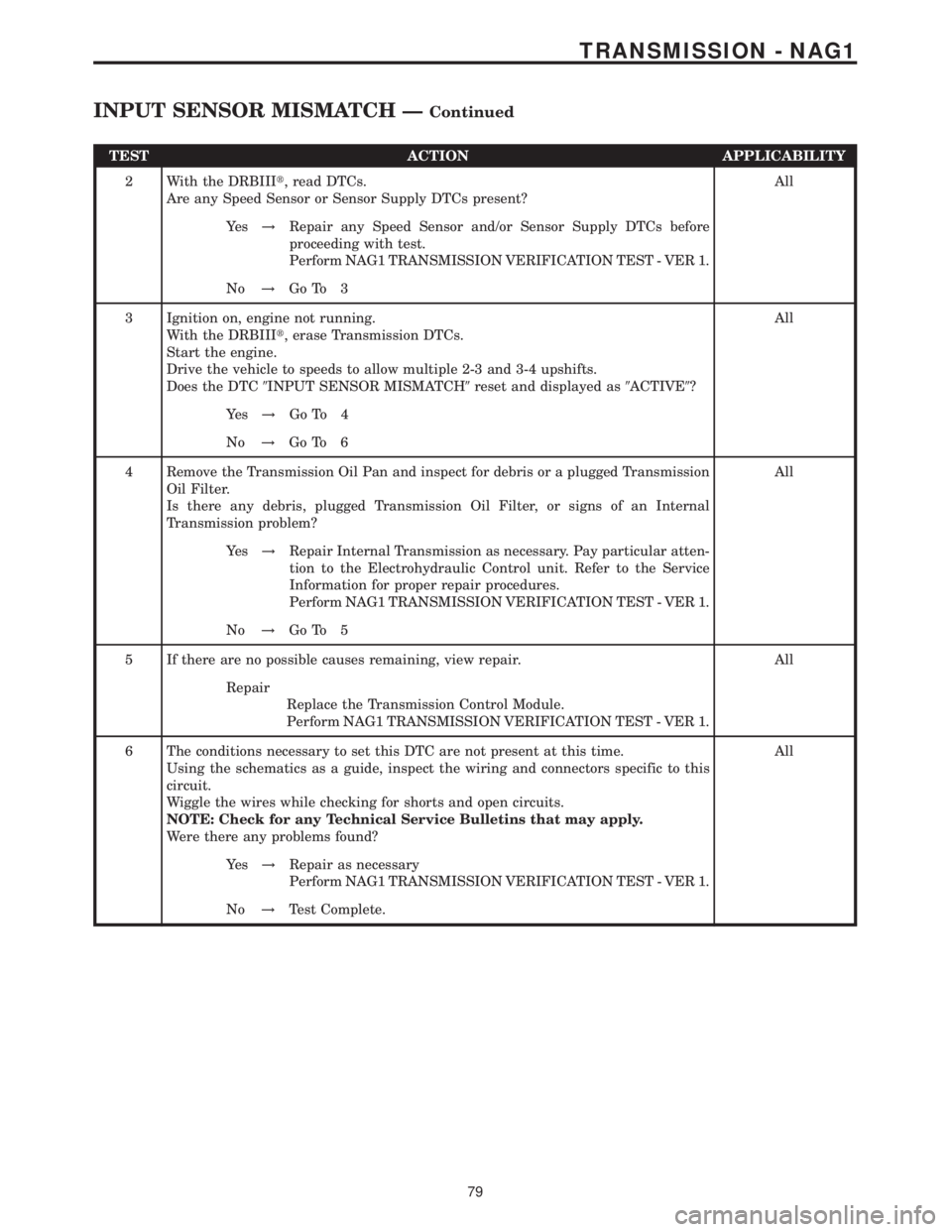
TEST ACTION APPLICABILITY
2 With the DRBIIIt, read DTCs.
Are any Speed Sensor or Sensor Supply DTCs present?All
Ye s!Repair any Speed Sensor and/or Sensor Supply DTCs before
proceeding with test.
Perform NAG1 TRANSMISSION VERIFICATION TEST - VER 1.
No!Go To 3
3 Ignition on, engine not running.
With the DRBIIIt, erase Transmission DTCs.
Start the engine.
Drive the vehicle to speeds to allow multiple 2-3 and 3-4 upshifts.
Does the DTC9INPUT SENSOR MISMATCH9reset and displayed as9ACTIVE9?All
Ye s!Go To 4
No!Go To 6
4 Remove the Transmission Oil Pan and inspect for debris or a plugged Transmission
Oil Filter.
Is there any debris, plugged Transmission Oil Filter, or signs of an Internal
Transmission problem?All
Ye s!Repair Internal Transmission as necessary. Pay particular atten-
tion to the Electrohydraulic Control unit. Refer to the Service
Information for proper repair procedures.
Perform NAG1 TRANSMISSION VERIFICATION TEST - VER 1.
No!Go To 5
5 If there are no possible causes remaining, view repair. All
Repair
Replace the Transmission Control Module.
Perform NAG1 TRANSMISSION VERIFICATION TEST - VER 1.
6 The conditions necessary to set this DTC are not present at this time.
Using the schematics as a guide, inspect the wiring and connectors specific to this
circuit.
Wiggle the wires while checking for shorts and open circuits.
NOTE: Check for any Technical Service Bulletins that may apply.
Were there any problems found?All
Ye s!Repair as necessary
Perform NAG1 TRANSMISSION VERIFICATION TEST - VER 1.
No!Test Complete.
79
TRANSMISSION - NAG1
INPUT SENSOR MISMATCH ÐContinued
Page 2245 of 2305
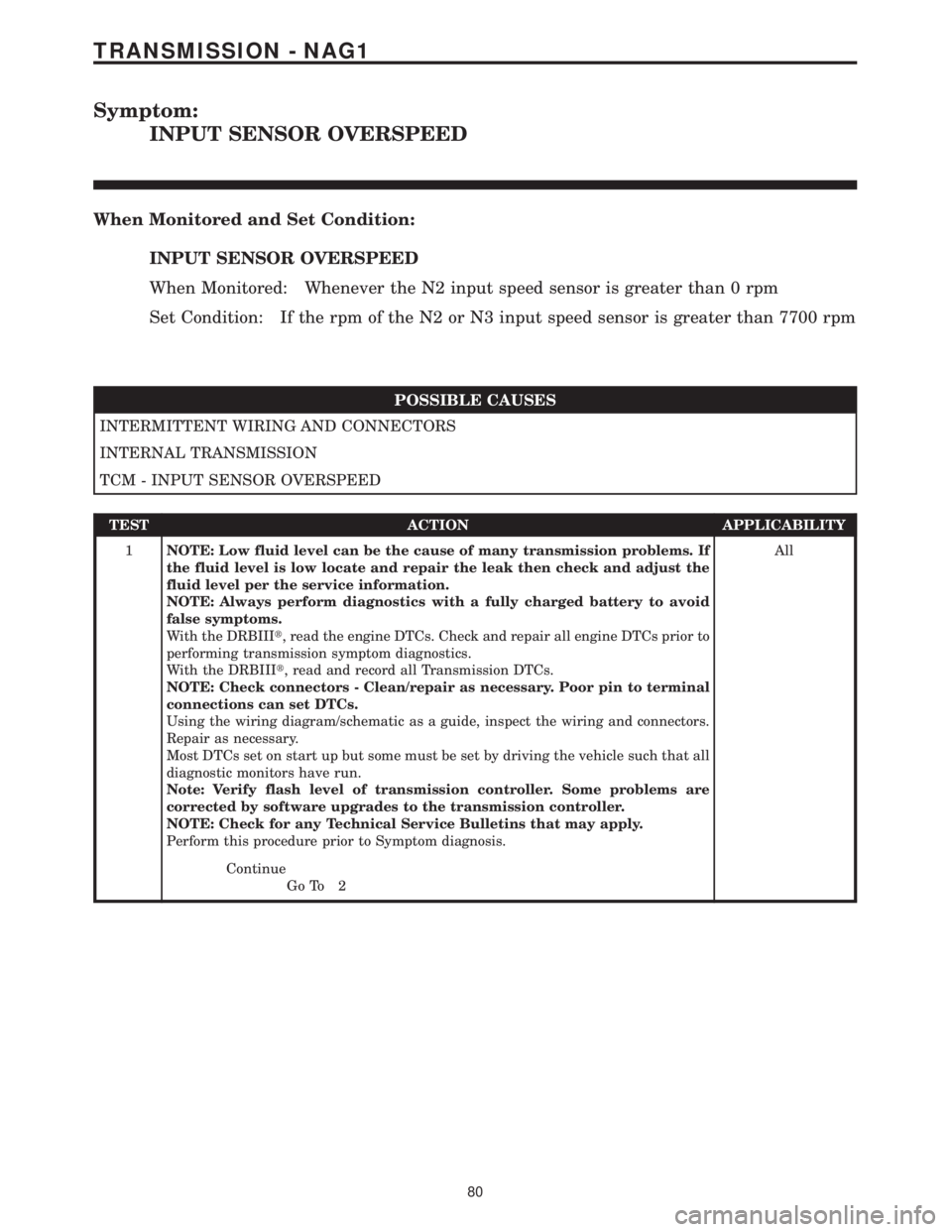
Symptom:
INPUT SENSOR OVERSPEED
When Monitored and Set Condition:
INPUT SENSOR OVERSPEED
When Monitored: Whenever the N2 input speed sensor is greater than 0 rpm
Set Condition: If the rpm of the N2 or N3 input speed sensor is greater than 7700 rpm
POSSIBLE CAUSES
INTERMITTENT WIRING AND CONNECTORS
INTERNAL TRANSMISSION
TCM - INPUT SENSOR OVERSPEED
TEST ACTION APPLICABILITY
1NOTE: Low fluid level can be the cause of many transmission problems. If
the fluid level is low locate and repair the leak then check and adjust the
fluid level per the service information.
NOTE: Always perform diagnostics with a fully charged battery to avoid
false symptoms.
With the DRBIIIt, read the engine DTCs. Check and repair all engine DTCs prior to
performing transmission symptom diagnostics.
With the DRBIIIt, read and record all Transmission DTCs.
NOTE: Check connectors - Clean/repair as necessary. Poor pin to terminal
connections can set DTCs.
Using the wiring diagram/schematic as a guide, inspect the wiring and connectors.
Repair as necessary.
Most DTCs set on start up but some must be set by driving the vehicle such that all
diagnostic monitors have run.
Note: Verify flash level of transmission controller. Some problems are
corrected by software upgrades to the transmission controller.
NOTE: Check for any Technical Service Bulletins that may apply.
Perform this procedure prior to Symptom diagnosis.All
Continue
Go To 2
80
TRANSMISSION - NAG1
Page 2246 of 2305
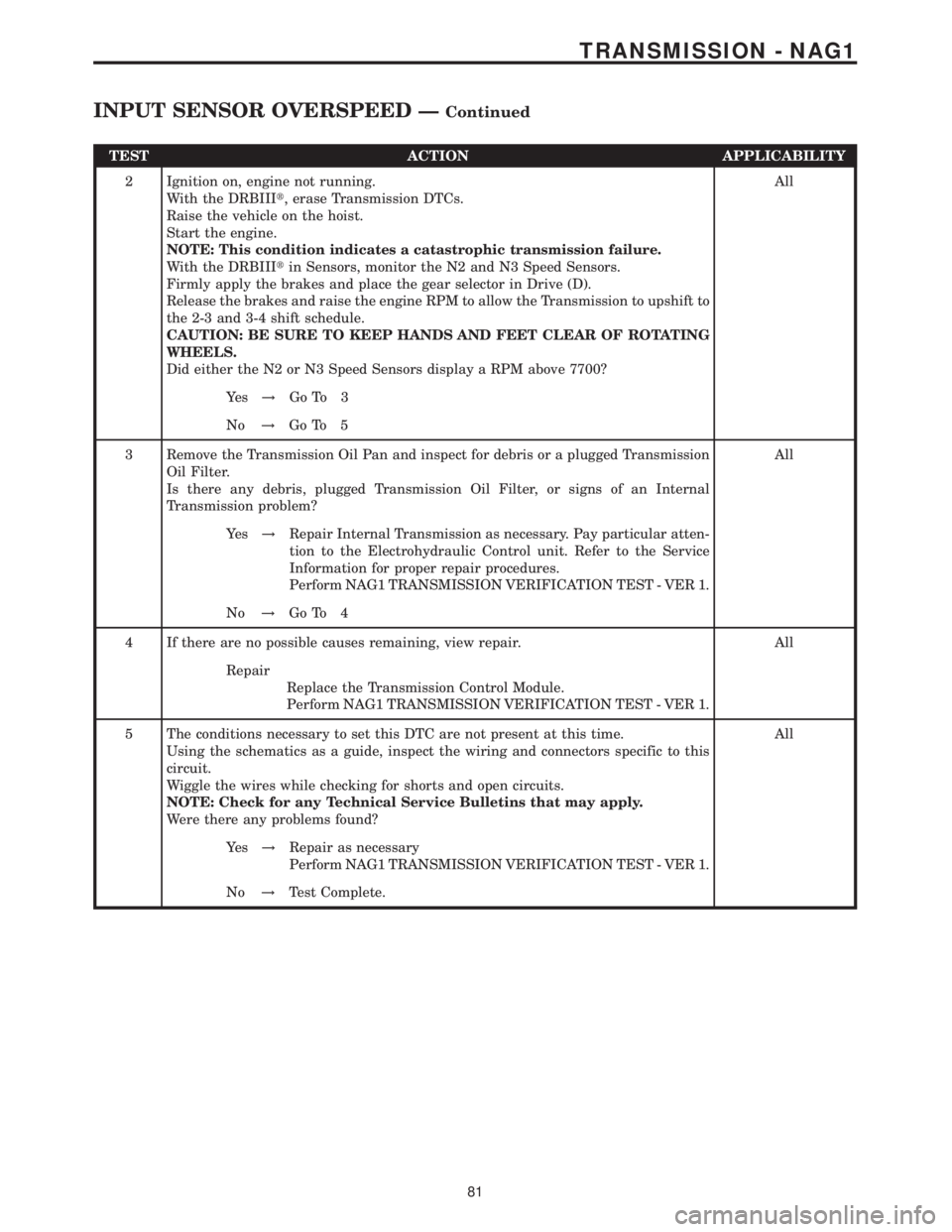
TEST ACTION APPLICABILITY
2 Ignition on, engine not running.
With the DRBIIIt, erase Transmission DTCs.
Raise the vehicle on the hoist.
Start the engine.
NOTE: This condition indicates a catastrophic transmission failure.
With the DRBIIItin Sensors, monitor the N2 and N3 Speed Sensors.
Firmly apply the brakes and place the gear selector in Drive (D).
Release the brakes and raise the engine RPM to allow the Transmission to upshift to
the 2-3 and 3-4 shift schedule.
CAUTION: BE SURE TO KEEP HANDS AND FEET CLEAR OF ROTATING
WHEELS.
Did either the N2 or N3 Speed Sensors display a RPM above 7700?All
Ye s!Go To 3
No!Go To 5
3 Remove the Transmission Oil Pan and inspect for debris or a plugged Transmission
Oil Filter.
Is there any debris, plugged Transmission Oil Filter, or signs of an Internal
Transmission problem?All
Ye s!Repair Internal Transmission as necessary. Pay particular atten-
tion to the Electrohydraulic Control unit. Refer to the Service
Information for proper repair procedures.
Perform NAG1 TRANSMISSION VERIFICATION TEST - VER 1.
No!Go To 4
4 If there are no possible causes remaining, view repair. All
Repair
Replace the Transmission Control Module.
Perform NAG1 TRANSMISSION VERIFICATION TEST - VER 1.
5 The conditions necessary to set this DTC are not present at this time.
Using the schematics as a guide, inspect the wiring and connectors specific to this
circuit.
Wiggle the wires while checking for shorts and open circuits.
NOTE: Check for any Technical Service Bulletins that may apply.
Were there any problems found?All
Ye s!Repair as necessary
Perform NAG1 TRANSMISSION VERIFICATION TEST - VER 1.
No!Test Complete.
81
TRANSMISSION - NAG1
INPUT SENSOR OVERSPEED ÐContinued